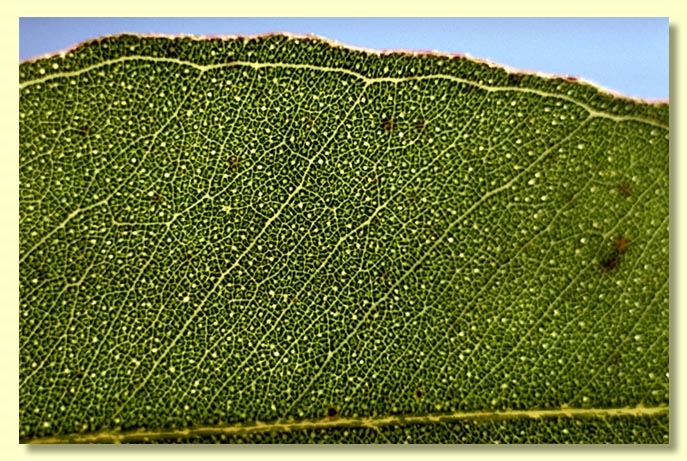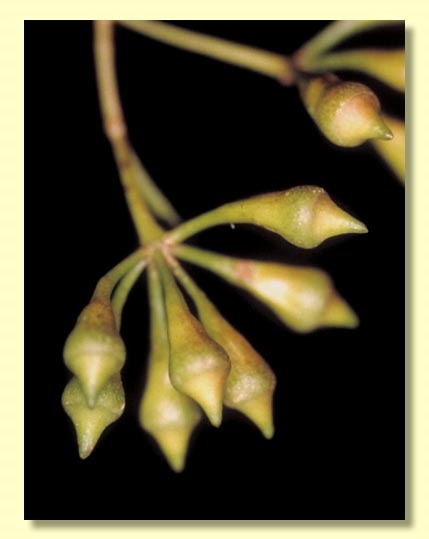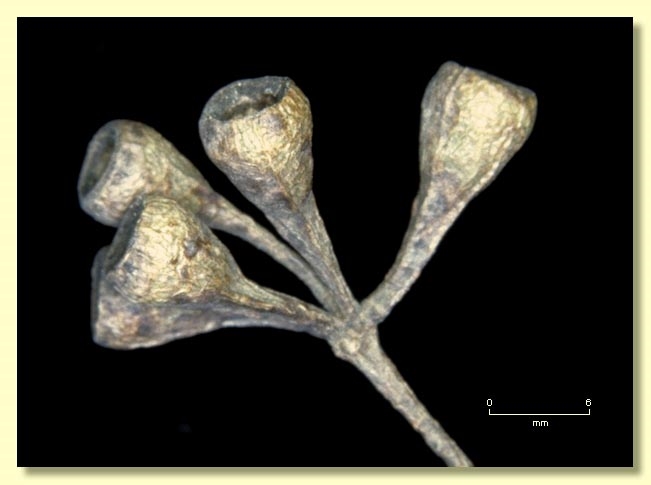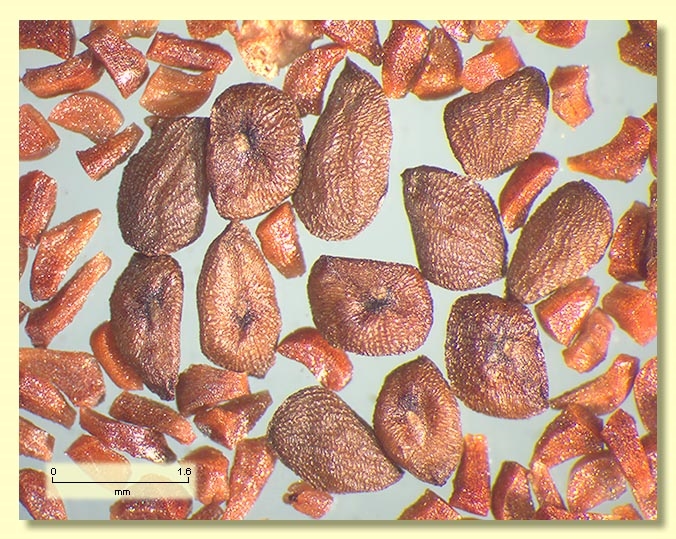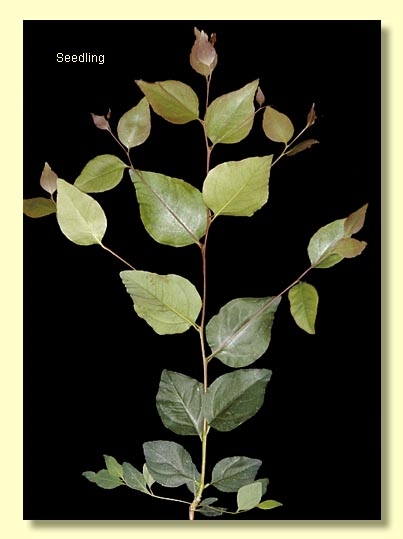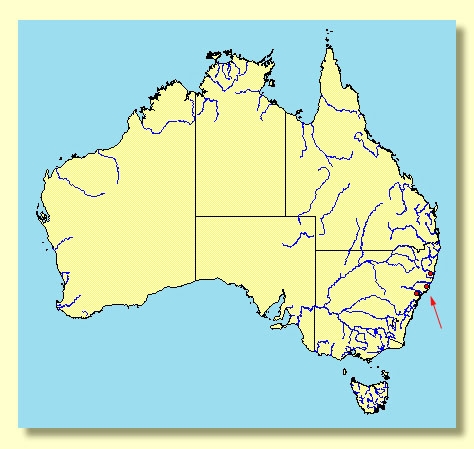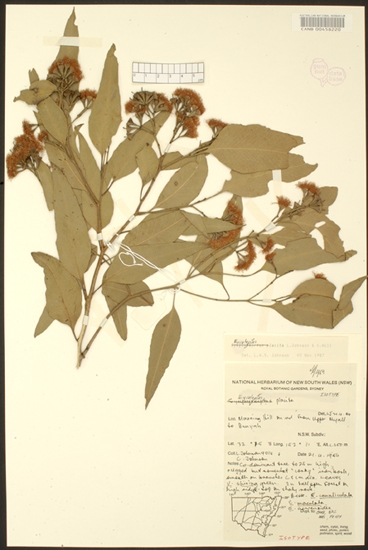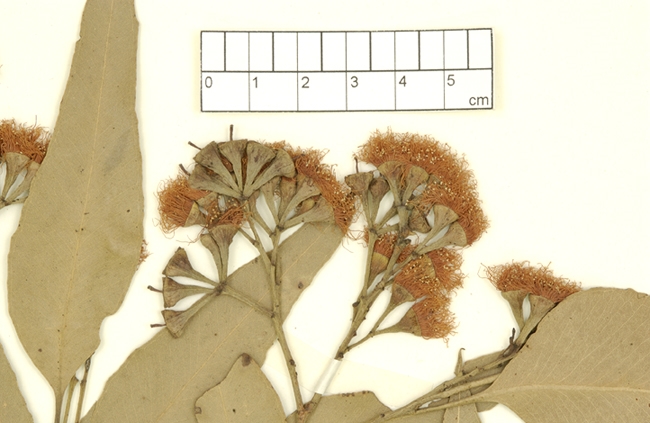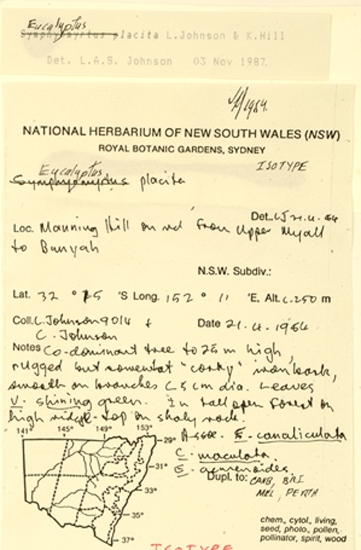Euclid - Online edition
Eucalyptus placita
Eucalyptus | Symphyomyrtus | Adnataria | Terminales | Rhodoxylon | Discolores
Ironbark, furrowed longitudinally and kino-impregnated, grey and, atypically for ironbark, soft; extending to smaller branches.
Juvenile growth (coppice or field seedlings to 50 cm): stem rounded or square in cross-section; juvenile leaves always petiolate, opposite for 3 to 7 nodes then alternate, broadly ovate, 5–8 cm long, 3–5 cm wide, base truncate, rounded or tapering to petiole, discolorous, glossy, bright green.
Adult leaves alternate, petiole 1–2 cm long; blade lanceolate, 6–12 cm long, 1.5–3.5 cm wide, base tapering to petiole, discolorous, glossy, green, side-veins greater than 45° to midrib, very densely reticulate, intramarginal vein parallel to and remote from margin, oil glands island and intersectional.
Inflorescence terminal compound, and sometimes small panicles in sub-terminal axils also, peduncles 0.6–1.7 cm long, buds 7 per umbel, pedicels 0.3–0.8 cm long. Mature buds clavate to ovoid or diamond-shaped, 0.6–0.7 cm long, 0.3–0.4 cm wide, green to brown, at times faintly angled longitudinally, outer operculum shed early and scar may be obscure in mature buds, operculum conical to beaked, stamens inflexed, with outer staminodes, anthers adnate, positioned obliquely at filament tip, cuboid to cuneate, dehiscing by terminal pores, style long, stigma blunt, locules 3 or 4, the placentae each with 4 vertical ovule rows. Flowers white.
Fruit on pedicels 0.4–0.9 cm long, obconical, 0.5–0.9 cm long, 0.5–0.7 cm wide, sometimes slightly angled longitudinally, disc descending, valves 3 or 4, enclosed.
Seeds brown, 1–2 mm long, flattened-ovoid, often pointed at one end, dorsal surface shallowly reticulate, hilum ventral.
Cultivated seedlings (measured at ca node 10): cotyledons reniform to oblong; stems square in cross-section; leaves always petiolate, opposite until nodes 3 or 4 then alternate, ovate, 5–9 cm long, 3.5–6 cm wide, base truncate to rounded to tapering, margin entire, apex pointed, discolorous, bright glossy green above, paler beneath.
Flowering has been recorded in April, June, September and October.
A small to medium-sized forest tree from the Cessnock district north to the hinterland from Kempsey. One of a group of ironbarks distinguished by the combination of discolorous leaves, terminal inflorescences, buds with staminodes and fruit with 3 or 4 valves. Eucalyptus placita is characterised by having very glossy bright green, discolorous leaves from seedling through to adult crown. In addition its ironbark feels spongy.
Eucalyptus placita is closely related to E. paniculata, E. decolor and E. sp. Dorsiventralis, all four species having distinctly discolorous adult leaves and belonging to the subseries Discolores.Within this group, E. placita is only weakly separated from E. paniculata. E. placita differs by having slightly broader, very glossy green juveniles leaves (up to 6 cm wide in E. placita and up to 4.5 cm wide in E. paniculata). E. decolor differs by having dull green adult leaves (glossy in E. placita) and E. sp. Dorsiventralis differs by having slightly larger buds and fruit, with buds and fruit distinctly four-sided (fruit in E. sp. Dorsiventralis 0.6–1 cm wide and 0.5–0.7 cm in E. placita).
Other closely related ironbark species that share the stamen characteristics of E. placita and which grow in close proximity are E. ancophila, E. fusiformis and E. beyeri. E. ancophila has narrower juvenile leaves and the adult leaves are only slightly discolorous. E. fusiformis has dull, concolorous adult leaves and more delicate, smaller buds and fruit and E. beyeri, which is of slightly more inland distribution, differs by having dull green to grey-green adult leaves and much smaller buds and fruit.
Three other ironbark species also found within the range of E. placita are E. crebra, E. fibrosa, and E. siderophloia, all of which differ in having concolorous leaves and buds with stamens all fertile and irregularly flexed.
Eucalyptus sideroxylon, of more inland distribution than E. placita, also differs by having concolorous dull adult leaves and by having buds that hold the outer operculum into maturity and both the inner and outer operculum shed together at anthesis (no operculum scar).
MORE ABOUT IRONBARKS


